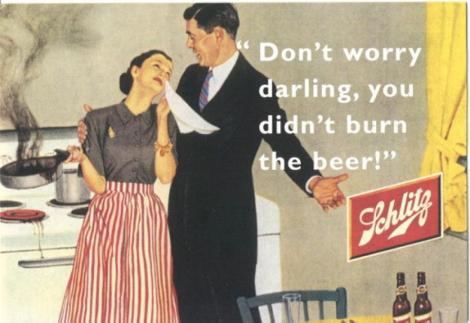
Idea and Political Argument
The idea that is being put forth by this advertisement of the Schlitz Brewing Company is that their beer is the only thing that can brighten the family life of a working man. It argues that wives are helpless in their everyday duties like cooking, which is visible by the destroyed pan in the female’s hand. Thus, the picture portrays an image of a servant female who is incapable of simple tasks and an indulgent and forgiving husband, a master.
Intended Audience and the Message
The picture was found in one of the historical magazines as a paid advertisement by the Schlitz Brewing Company. The intended audience was working, middle-class men, predominantly white, with a family. The ad attempts to reflect the reality of that time: many women were housewives, while men went to work to sustain the household. Men who saw this image were meant to relate to the ad in the sense that they saw a similar scenario in their everyday life. This accurate portrayal also directs them to a solution to family values’ redundancies, which is an alcoholic beverage.
Picture’s Context and History
The advertisement was created and published in 1952. As a postwar period, it heavily promoted highly limiting gender roles: women were confined to keeping the home cozy and clean for the working husband to enjoy. After World War II, the family became the center of prosperous American life, and domesticity was highly promoted as the only possible focus of women’s lives. Most females gave up their professions, ambitions, and education to become housewives. Thus, the ad is the product of the common, socially imposed stereotype of an ideal postwar American family.
Visual Details
The advertisement portrays two people, a husband, and a wife, standing together in a kitchen, emphasizing their interaction. Behind the couple, an audience can observe a messy kitchen stove, and in front of them, the table with two bottles of beer is placed. A wife has a burning pain in her hand, as well as a napkin to help with the tears. Her clothing, specifically a skirt, is bright, and makes her blend with the household’s surroundings, indicating that it is her occupation. Man, on the other hand, is dressed in a monochrome suit and smiles at his wife’s misery. His formal wear makes him feel out of place, like he does not belong to the housewife’s kitchen, and is there only as a guest. The background color scheme communicates the mood of man’s happiness about the fact that his wife did not burn at least something in the kitchen. The atmosphere resonates with the husband, which devalues his wife’s tears, and, despite his alleged forgiveness, conveys man’s dominance in the situation.
Text
The text is what shapes and reinforces the message of gender stereotypes of the image. The caption reads, “Don’t worry darling, you didn’t burn the beer!” and highlights the wife’s role as a servant. The text, written in a modern and professional-looking typeface, displays what the husband says to his wife, who failed in cooking. The textual component emphasizes man’s indulgent and forgiving personality and the fact that he has to do all the work, while his wife cannot cope with basic everyday tasks.
Target Demographic
Schlitz Brewing Company was one of the biggest producers of beer in the US throughout the 20th century, and has been positioned as “The beer that made Milwaukee famous.” As it is an alcoholic beverage brand that peaked at the start and middle of the last century, it is safe to assume that it targeted working-class men. As apparent from the advertisement, the company did not aim for women audience as a viable demographic.
Work Cited
Schlitz Brewing Company. Don’t worry darling, you didn’t burn the beer! 1952. Schlitz Brewing Company, Texas. Schlitz’s History.